中职英语基础模块Unit 1
- 格式:doc
- 大小:60.50 KB
- 文档页数:14




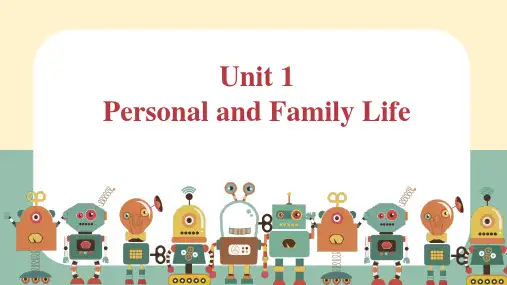
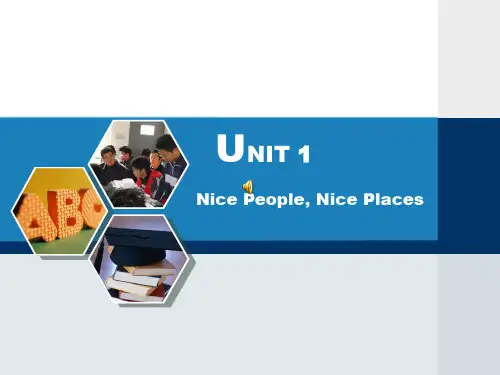

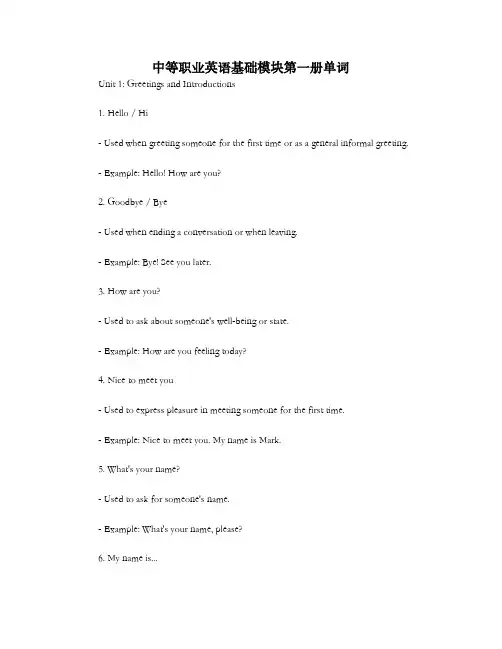
中等职业英语基础模块第一册单词Unit 1: Greetings and Introductions1. Hello / Hi- Used when greeting someone for the first time or as a general informal greeting. - Example: Hello! How are you?2. Goodbye / Bye- Used when ending a conversation or when leaving.- Example: Bye! See you later.3. How are you?- Used to ask about someone's well-being or state.- Example: How are you feeling today?4. Nice to meet you- Used to express pleasure in meeting someone for the first time.- Example: Nice to meet you. My name is Mark.5. What's your name?- Used to ask for someone's name.- Example: What's your name, please?6. My name is...- Used to introduce oneself and provide the name.- Example: My name is Emily. Nice to meet you.7. Where are you from?- Used to ask about someone's place of origin.- Example: Where are you from originally?8. I'm from...- Used to state one's place of origin.- Example: I'm from France. What about you?9. How old are you?- Used to ask about someone's age.- Example: May I ask how old you are?10. I'm... years old.- Used to state one's age.- Example: I'm 25 years old. How about you?Unit 2: Numbers1. Zero- The numerical symbol representing the value of nothing or no quantity. - Example: There are zero seats available.- The numerical symbol representing the value of a single unit or entity. - Example: I have one sister.3. Two- The numerical symbol representing the value of two units or entities. - Example: I need two cups of coffee.4. Three- The numerical symbol representing the value of three units or entities. - Example: I have three cats.5. Four- The numerical symbol representing the value of four units or entities. - Example: There are four chairs in the room.6. Five- The numerical symbol representing the value of five units or entities. - Example: I have five fingers on each hand.7. Six- The numerical symbol representing the value of six units or entities. - Example: She has six books on her shelf.- The numerical symbol representing the value of seven units or entities. - Example: We'll meet at seven o'clock.9. Eight- The numerical symbol representing the value of eight units or entities. - Example: I'll be there in eight minutes.10. Nine- The numerical symbol representing the value of nine units or entities. - Example: There are nine planets in our solar system.Unit 3: Colors1. Red- The color associated with passion, love, and intensity.- Example: She was wearing a stunning red dress.2. Blue- The color associated with calmness, serenity, and stability.- Example: The sky is a beautiful shade of blue today.3. Yellow- The color associated with happiness, joy, and energy.- Example: The sunflowers are bright yellow.4. Green- The color associated with nature, growth, and freshness.- Example: The leaves on the trees are a vibrant green.5. Orange- The color associated with enthusiasm, creativity, and warmth. - Example: He painted the walls in a lovely shade of orange. 6. Purple- The color associated with royalty, luxury, and power.- Example: The queen wore a regal purple gown.7. Pink- The color associated with femininity, sweetness, and kindness. - Example: The baby girl's room is painted in soft pink.8. Brown- The color associated with earthiness, stability, and reliability. - Example: His eyes are a warm shade of brown.9. Black- The color associated with formality, elegance, and mystery.- Example: She wore a black evening gown to the party.10. White- The color associated with purity, innocence, and cleanliness.- Example: The bride wore a white wedding dress.This document provides a comprehensive list of basic words related to the Middle Vocational English Module 1. The topics covered include greetings and introductions, numbers, and colors. Each unit contains ten words, along with brief explanations and examples. These words will help you build a solid foundation in the English language.。
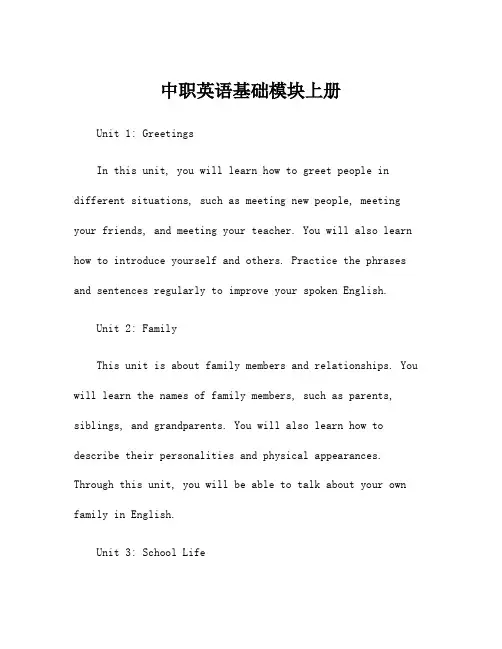
中职英语基础模块上册Unit 1: GreetingsIn this unit, you will learn how to greet people in different situations, such as meeting new people, meeting your friends, and meeting your teacher. You will also learn how to introduce yourself and others. Practice the phrases and sentences regularly to improve your spoken English.Unit 2: FamilyThis unit is about family members and relationships. You will learn the names of family members, such as parents, siblings, and grandparents. You will also learn how to describe their personalities and physical appearances. Through this unit, you will be able to talk about your own family in English.Unit 3: School LifeIn this unit, you will learn school-related vocabulary and phrases. You will learn the names of school subjects, school facilities, and school activities. You will also learn how to talk about daily routines and school events. The goal is to enable you to communicate about your school life confidently.Unit 4: HobbiesThis unit focuses on discussing hobbies and interests in English. You will learn how to express your likes and dislikes, as well as talk about your hobbies. You will also learn how to ask others about their hobbies and interests. By the end of this unit, you should be able to have conversations about hobbies with others.Unit 5: Daily RoutinesIn this unit, you will learn how to talk about your daily routines and activities. You will learn the vocabulary for daily activities, such as waking up, bathing, eating meals,and going to bed. By mastering the content of this unit, you will be able to describe your typical day to others.Unit 6: Plans and SchedulesThis unit will teach you how to discuss future plans and schedules in English. You will learn vocabulary related to making plans, scheduling events, and discussing future activities. You will also learn how to use time-related expressions to talk about future events. After completing this unit, you should be able to make plans with others and talk about your future schedule confidently.Overall, the Basic Module of Junior Vocational English covers essential topics for daily communication. It aims to equip learners with the necessary language skills to communicate effectively in various social and work-related situations. Regular practice and review of the content is crucial for mastering the material.。
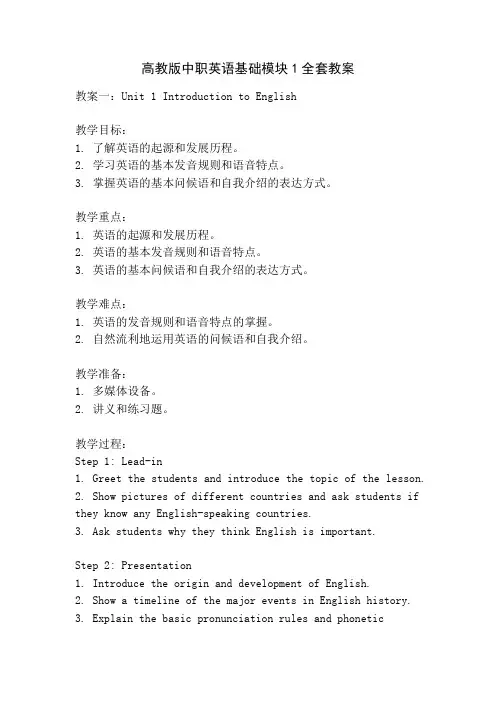
高教版中职英语基础模块1全套教案教案一:Unit 1 Introduction to English教学目标:1. 了解英语的起源和发展历程。
2. 学习英语的基本发音规则和语音特点。
3. 掌握英语的基本问候语和自我介绍的表达方式。
教学重点:1. 英语的起源和发展历程。
2. 英语的基本发音规则和语音特点。
3. 英语的基本问候语和自我介绍的表达方式。
教学难点:1. 英语的发音规则和语音特点的掌握。
2. 自然流利地运用英语的问候语和自我介绍。
教学准备:1. 多媒体设备。
2. 讲义和练习题。
教学过程:Step 1: Lead-in1. Greet the students and introduce the topic of the lesson.2. Show pictures of different countries and ask students if they know any English-speaking countries.3. Ask students why they think English is important.Step 2: Presentation1. Introduce the origin and development of English.2. Show a timeline of the major events in English history.3. Explain the basic pronunciation rules and phoneticfeatures of English.4. Use audio or video materials to demonstrate the correct pronunciation.Step 3: Practice1. Divide the class into pairs or small groups.2. Give students a list of common greetings and ask them to practice using them in different situations.3. Have students practice introducing themselves to each other using the phrases and sentences learned.Step 4: Consolidation1. Review the key points of the lesson, including theorigin and development of English, pronunciation rules, and greetings.2. Ask students to summarize what they have learned intheir own words.Step 5: Assessment1. Give students a short quiz to test their understanding of the lesson.2. Assign homework, such as writing a short paragraph about the importance of English or practicing greetings and self-introductions.教案二:Unit 2 Numbers and Time教学目标:1. 学习基本的数字和时间表达方式。
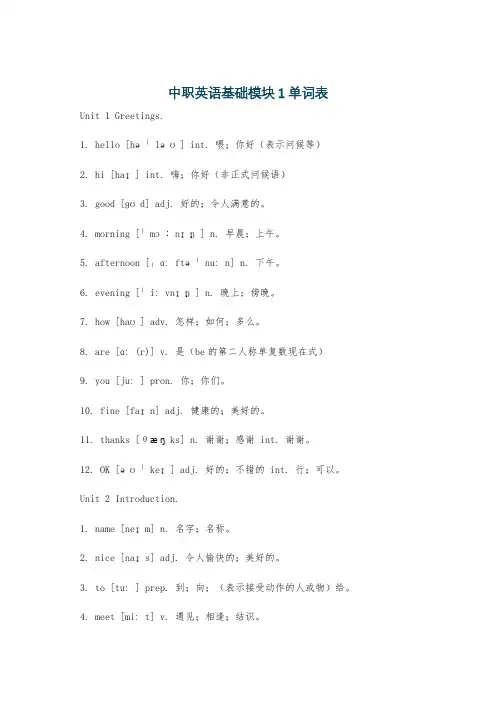
中职英语基础模块1单词表Unit 1 Greetings.1. hello [həˈləʊ] int. 喂;你好(表示问候等)2. hi [haɪ] int. 嗨;你好(非正式问候语)3. good [ɡʊd] adj. 好的;令人满意的。
4. morning [ˈmɔːnɪŋ] n. 早晨;上午。
5. afternoon [ˌɑːftəˈnuːn] n. 下午。
6. evening [ˈiːvnɪŋ] n. 晚上;傍晚。
7. how [haʊ] adv. 怎样;如何;多么。
8. are [ɑː(r)] v. 是(be的第二人称单复数现在式)9. you [juː] pron. 你;你们。
10. fine [faɪn] adj. 健康的;美好的。
11. thanks [θæŋks] n. 谢谢;感谢 int. 谢谢。
12. OK [əʊˈkeɪ] adj. 好的;不错的 int. 行;可以。
Unit 2 Introduction.1. name [neɪm] n. 名字;名称。
2. nice [naɪs] adj. 令人愉快的;美好的。
3. to [tuː] prep. 到;向;(表示接受动作的人或物)给。
4. meet [miːt] v. 遇见;相逢;结识。
5. too [tuː] adv. 也;又;太。
6. his [hɪz] pron. 他的。
7. her [hɜː(r)] pron. 她的。
8. your [jɔː(r)] pron. 你的;你们的。
Unit 3 Family.1. family [ˈfæməli] n. 家庭;家族。
2. father [ˈfɑːðə(r)] n. 父亲;爸爸。
3. mother [ˈmʌðə(r)] n. 母亲;妈妈。
4. parent [ˈpeərənt] n. 父(母)亲。
5. brother [ˈbrʌðə(r)] n. 兄弟。
Unit 1单元知识清单重点单词1.Delivery person外卖员2.Firefighter消防员3.Flight attendant空乘服务员4.Cook v.烹饪n.厨师5.Notice注意6.Parent父亲或母亲7.Parents父亲和母亲8.Photo照片(复数加s)9.Younger sister 妹妹10.O ld sister 姐姐11.F amous著名的12.(in)formal正式的13.A ddressing称呼14.A ncestors祖先15.M ajority大部分16.F ew少量17.S ubject学科主题18.C ompany公司19.E arth地球20.R ecommend推荐21.F orget忘记22.L ate达到23.A rrive到达24.A rrive抵达25.L azy懒惰26.M aybe也许重点短语1.For in stance=for example 例如2.It is said据说3.Primary school小学e from来自5.Keep in mind记住6.Pay attention to注意到7.High-speed rail高铁cating the young教书(育人)9.Save food节约粮食10.Save water节约用水11.By the way ,... 顺便说12.welcome to...欢迎到……来13.be glad to do很高兴做14.look at看……15.have a look at看一下16.classroom building教学楼17.a lot of =lots of=many许多(修饰可数名词复数)18.much(修饰不可数名词)19.reading room阅览室20.after class课后21.in class 课堂上22.next to靠近;紧挨着23.thank for 为……而感谢……24.thank sb.for sth. 为某事感谢某人25.thanks to...多亏,由于26.let sb. do sth.让某人做某事27.Here we are!我们到了!28.How large it is!多么大呀!29.See you next time!下次见30.on one’s way to 在某人去某地的路上31.in this way 用这种方法重点句型1.I am very glad to meet you here today.我很高兴今天能在这儿见到你。
Unit1 personal and family life.community kəˈmjuːnəti社区; 社会; 团体; 社团; 界; 共享; 共有; (动植物的)群落; cook/kʊk/烹调,煮,烧炊事员,厨师energetic/enəˈdʒetɪk/精力旺盛的especially/ɪs'peʃəli/特别;尤其family/'fæmɪli/家,家庭gift/ɡɪft/赠品;礼物handmade hændˈmeɪd手工制作的;introduce/ɪntrəˈdjuːs/介绍jog/dʒɒɡ/慢跑manager/'mænɪdʒə/经理,负责人notice/'nəʊtɪs/通告,布告parent/'peərənt/父(母)亲photo/'fəʊtəʊ/照片puppy/'pʌpi/自负的年轻人strict/strɪkt/严格的,严密的visit/'vɪzɪt/访问,参观,拜访vocational vəʊˈkeɪʃənl职业的; 职业技术的; 业务知识的;be strict with bi strɪkt wɪð严格要求; 对某人要求严格;Chongyang Festival chongyang ˈfestɪvl重阳节; 重陽節;high schoolˈhaɪ skuːl中学,高中;younger sister'jʌŋɡər ˈsɪstər妹妹; 阿妹; 小妹妹;UNIT2 Transportationaddress/ə'dres/地址airport/'eəpɔːt/航空站,飞机场change/tʃeɪndʒ/变化,变更,改变convenient/kənˈviːnɪənt/便利的,方便的direction/dɪˈrekʃ(ə)nˌdaɪˈrekʃ(ə)n/方向;方位district/ˈdɪstrɪkt/区;地区;区域express/ɪks'pres/表达;表示;表情快车,特快专递green/griːn/绿色(的)hire/ˈhaɪə/租用near/nɪə/在...附近province/ˈprɒvɪns/省subway/'sʌbweɪ/n. 地铁taxi/'tæksi/出租汽车terminal/tɜːm/(火车汽车飞机)终点站visitor/'vɪzɪtə/参观者,访问者bus stopˈbʌs stɒp公交站; 公共汽车停靠站;get off/ˈgetɒf/来,从...下来get toɡet tu到达; 开始; 抵达; 抓住; 接触; 和…取得联系;take a taxi teɪk ə ˈtæksi乘出租车,搭出租车;rush hourˈrʌʃ aʊə(r)(上下班时的)交通高峰期;shuttle busˈʃʌtl bʌs班车; 区间(公共汽)车;Summer Palaceˈsʌmə(r) ˈpæləs颐和园;worry aboutˈwʌri əˈbaʊt担心; 担忧; 发愁; 为…发愁; 替…担忧;you'd better juːd ˈbetə(r)你最好;UNIT3 Shoppingadd/æd/添加,增加bestsellingˌbestˈselɪŋ(书等)畅销的,抢手的,大卖的;beverage/'bevərɪdʒ/n. 饮料cart kɑːt"运货马车; 手推车; 用马车运送; 用手提(笨重物品); 强行带走; 抓走; communication/kəmjuːnɪˈkeɪʃ(ə)n/交际,交往;通讯compare/kəmˈpeə/比较,对照cotton/ˈkɒtn/棉花customer/ˈkʌstəmə/(商店)顾客,主顾discount/ˈdɪskaʊnt/折扣edition/ɪˈdɪʃ(ə)n/(发行物的)版,版(本)feature/fiːtʃə/特征,容貌,特色;是...的特色,特写;起重要作用fit/fɪt/健康的;适合的;(使)适合font fɒnt圣洗池(设于教堂中,常为石造); (同样字体和字号的)一副铅字,字模,字型; jeans/dʒiːns/牛仔裤mall/mɔːl/铁圈球,林荫道material/məˈtɪərɪəl/材料,原料offer/'ɔːfə/拿出;提供online/ˌɒnˈlaɪn/在线,上网original/ə'rɪdʒənl/a. 最初的,原始的,有独创性的,原版的; n. 起源,原件,原稿rating/'reɪtɪŋ/n. 等级review/rɪ'vjuː/复习(功课等)silk/sɪlk/(蚕)丝size/saɪz/尺寸,大小snack/snæk/小吃stationeryˈsteɪʃənri文具; 信纸; 信笺;style/staɪl/方式,作风,款式sweater/'swetə/毛衣,厚运动衫tight/taɪt/紧的traditional/trə'dɪʃənəl/传统的,惯例的workplace/'wɜːkpleɪs/工作场所comvenience store kənˈviːniəns stɔː(r)便利店(常为24小时营业);fitting room/ˈfɪtɪŋ-rʊm/试衣间lead the way to带路,领路,引路on saleɒn seɪl出售; 上市; 折价销售; 减价出售;payment codeˈpeɪmənt kəʊd支付代码;pay with用……付款;shop assistantˈʃɒp əsɪstənt售货员; 店员;UNIT4 School Lifechemistry/'kemɪstri/化学college/ˈkɒlɪdʒ/学院,高等专科学校competition/ˌkɒmpɪˈtɪʃən/比赛;竞争exciting/ɪk'saɪtɪŋ/令人兴奋的experience/ɪks'pɪərɪəns/经验,体验favorite/ˈfeɪvərɪt/特别受喜爱的特别喜爱的人(或物)fun/fʌn/有趣的;愉快的hall/hɔːl/大厅,会堂,会馆hands-on hændz ˈɒn实际操作的; 动手的;hold/həʊld/拿,握interesting/'ɪntərɪstɪŋ/有趣的,有意思的internshipˈɪntɜːrnʃɪp实习;major/ˈmeɪdʒə/较大的;主要的physics/'fɪzɪks/物理(学)politics/ˈpɒlɪtɪks/政治practice/'præktɪs/练习,实践relaxing/rɪ'læksɪŋ/a.轻松的related rɪˈleɪtɪd相关的; 有联系的; 属同一家族的;联系; 使有联系; 把…联系起来; skilI skɪl"技巧; 技艺; 技术; 技能;有助于;有影响;〈古〉起作用;"skilled/skiː/熟练的;有技能的special/'speʃəl/特别的,特殊的subject/'sʌbdʒɪkt/题目,题材training/'treɪnɪŋ/训练,培养Information Technology(IT)ɪnfəˌmeɪʃn tekˈnɒlədʒi信息技术practical trainingˈpræktɪkl ˈtreɪnɪŋ实习; 实训; 实践训练; 实习机会; 实习许可; prepare...for...准备; 把…预备好; 使(自己)有准备; 防范;sound like saʊnd laɪk听起来像;UNIT5 Celebrationsattend/əˈtend/看护,照料,服侍;出席,参加attendanceəˈtendəns出席; 参加; 上学; 到场; 出席人数;banquetˈbæŋkwɪt宴会; 盛宴; 筵席;宴请;beat/biːt/打败,敲打cafeteria/kæfɪˈtɪərɪə/自助餐厅celebrate/'selɪbreɪt/庆祝ceremony/ˈserɪməni/典礼,仪式,礼节common/ˈkɒmən/普通,一般;共有的confirm/kənˈfɜːm/证实,证明,确认employee/ɪmˈplɔɪ-iː/受雇者,雇工,雇员event/ɪ'vent/大事;事件growth/ɡrəʊθ/生长,增长invitation/ɪnvɪˈteɪʃ(ə)n/邀请,请帖invite/ɪn'vaɪt/邀请,招待marketingˈmɑːkɪtɪŋ促销; 营销; 销售活动;opportunity/ˌɒpəˈtjuːnɪti /机会,时机partner/ˈpɑːtnə/搭档,合作者preparation/prepəˈreɪʃ(ə)n/准备sincerely/sɪn'sɪrli/-'sɪəl-/真诚地support/səˈpɔːt/支持,赞助help with help wɪð帮助(某人做……); 用……来帮助;in commonɪn ˈkɑːmən(兴趣或经历)共同的,相同的; 共有的;相同的;invite.to.邀请参加look/lʊk/瞧,看forward toˈfɔːwəd tu附送;need a hand(with..)'ni:də hænd wið需要帮忙on behalf ofɒn bɪˈhɑːf ɒv代表某人,作为某人的代言人; 为了某人的利益,为了某人; opening ceremonyˈəʊpənɪŋ ˈserəməni开幕式;play an important role in ..在...中起重要作用UNIT6 Food and Drinkscozyˈkəʊzi"(温暖)舒适的;保温罩;蒙骗; 抚慰;cuisine/kwɪˈziːn/饭菜,佳肴dining/'daɪnɪŋ/n. 就餐environment/ɪn'vaɪrənmənt/环境factorˈfæktə(r)因素; 因子;把…因素包括进去; (数学)分解…的因子,将…分解成因子; famous/'feɪməs/有名的,著名的medium/ˈmiːdɪəm/媒体,中间的,中等的mushroom/ˈmʌʃrʊm/蘑菇order/'ɔːdə/订购,点菜订购单,定购,一份菜proper/ˈprɒpə/恰当的,合适的quality/ˈkwɒlɪti/质量,性质recommend/rekəˈmend/推荐restaurant/ˈrestərɒnt/饭馆rare/reə/罕见的,稀有的ruin/ˈruːɪn/(使)毁坏;(使)毁灭(复)废墟;遗迹specialtyˈspeʃəlti专业; 专长; (某个地方的)特色食品; 特产;spicyˈspaɪsi辛辣的; 加有香料的; 用香料调味的; 刺激的; 粗俗的;unwiseʌnˈwaɪz愚蠢的; 不明智的; 轻率的;variety/vəˈraɪəti/种种,种类various/ˈveərɪəs/各种各样的,不同的well-donewel ˈdʌn干得好的;完全煮熟的;wiselyˈwaɪzli明智地; 聪明地;英明地;apart froməˈpɑːt frəm除了; 除了…外(都); 要不是; 此外; 加之;be able to bi ˈeɪbl tu能够; (因具有品质或技能)能做到…的;contribute to kənˈtrɪbjuːt tu贡献; 捐助; 给…投稿; 捐(款)给;eat out iːt aʊt出去吃饭; 出去吃; 在外面吃饭;mineral waterˈmɪnərəl wɔːtə(r)矿泉水; 一杯(或一瓶)矿泉水;pay attention to peɪ əˈtenʃn tu注意price range praɪs reɪndʒ价格区间;tend to tend tu倾向于; 有助于;UNIT7 The Internetclick/klɪk/咔哒声;发出咔哒声desired dɪˈzaɪəd渴望; 期望; 想望; 被(某人)吸引;fresh/freʃ/新鲜的icon/ˈaɪkɒn/图象符号,图标interview/ˈɪntəvjuː/采访,会见,面试mobile/'məʊbɪl/可移动的passer-by/'pɑːsə-baɪ/过客,过路人poem/ˈpəʊɪm/诗popular/ˈpɒpjʊlə/大众的,流行的ring/rɪŋ/(钟,铃等)响,摇铃selfieˈselfi自拍;spare/speə/空闲,多余的,剩余的takeoutˈteɪˌkaʊt外卖店; 外卖餐馆; (商店、餐馆的)外卖食品typical/ˈtɪpɪk(ə)l/典型的,有代表性的,特有的unlockʌnˈlɑːk(用钥匙)开…的锁; 发现; 揭示; 揭开; concentrate onˈkɒnsntreɪt ɒn专心于,把思想集中于; 将…集中于…; go over/'gəʊˌəʊvə(r)/过一遍,仔细检查have access to hæv ˈækses tu得接近; 得会见; 得进入;log onto lɒɡˈɒntə登录; 登录到; 进入系统; 听音乐和上网; 登陆; stay up steɪ ʌp不睡; 熬夜;UNIT8 People and Eventsbelieve/bɪ'liːv/相信,认为brilliant/ˈbrɪljənt/<口>好极了chat/tʃæt/聊天,闲谈chief/tʃiːf/主要,首要的领导,头complete/kəmˈpliːt/完成完成,结束consider/kənˈsɪdə/考虑design/dɪˈzaɪn/设计,策划图案,图样,样式graduation/ɡrædjʊˈeɪʃ(ə)n/毕业,毕业典礼invent/ɪn'vent/发明,创造invention/ɪn'venʃən/发明,创造overcome/əʊvəˈkʌm/克服,解决record/ˈrekɔːd/记录;唱片schedule/ˈʃedjuːl/工作计划,日程安排安排时间,预定stretch/stretʃ/伸展拉长一段时间(路程);伸展ahead ofəˈhed əv(时间、空间)在…前面; 早于; 领先;schedule/ˈʃedjuːl/工作计划,日程安排安排时间,预定ebook reader电子书阅读器;return to rɪˈtɜːn tu回到; 返回; 还给; 降到;show an interest in对……表现出兴趣;succeed in səkˈsiːd ɪn成功于;。
Unit One GreetingObjectives:By the end of this unit, the students should be able to:1) read, discuss and translate business cards in English,2) learn some expressions used in greeting and introducing people,3) comprehend the two passages and master the useful expressions in them,4) finish the exercises by themselves or with some help.IntroductionLead-in(导入):First, the students are asked to talk about how to greet and introduce people. Then their opinions are written down on the blackboard. Finally, the introductory remarks will be made by the teacher as follows:In social interactions, greeting and introducing people are very important. An appropriate introduction will help you leave a good first impression upon others, which means you may be likely to establish a close relationship with others, and vice versa. When you are introduced to foreign friends, you should greet them with “How do you do?" while shaking hands with them for a few seconds. The next thing is, perhaps, the presenting of a business card, which is also called a name card. You should accept the card with a smile and a quick browse, and at the same time, offer yours.Unit One Part I Section I. Warming up & Reading I.Presentation: Make a brief self-introduction, introduce how to study English in collegeII.Warm-upBusiness cards are very useful for introducing people. Now let's read the following business cards.Sample 1 Sample 2 on bookSome useful expressions (refer to the Data Bank in the Work Book)III.Read the passageAsk the students to skim the passage.IV.Analyze the passage, and explain the language points and difficult sentences.(In this step, some related information will be provided for the students.) Formation of Common English NamesA common English name is usually composed of two or three parts: the first name is also called forename. If the person is a Christian, his first name will be given at his baptism, so it is also called the given name or the Christian name. Middle name is the second given name. When written, middle name is often shortened to the initial letter. Surname is often the father’s family name, so it is also called family name or last name. For example: Anne Louise Strong, George W. Bush.Ask the students to skim the passage and answer the questions.①. What does an informal greeting really mean to Americans?②. Why don’t most Americans like using titles in introductions?③. What do your American friends want to show when they address you with your first name?④. Why do Americans ask you some personal questions?Analyze the passage, and explain the language points and difficult sentences(1) Explanation of Difficult Sentences①(Title) The Way American GreetAnalysis: In this title, "in which" is omitted after The Way.“in… way” means (to do something) by means of a certain method. Translation: 美国人的致意方式Example: I think the way she studies is worth studying.②(Para. 1) Speaking of …time, I’ve got to run.Analysis: "Speaking of" is a present participle clause used as an adverbial of cause/time. It means “when it comes to time, I’m reminded of …”Translation: 说到时间,我得赶紧跑了。
Example: a. Speaking of English, I’ve go to a class. 谈到英语,我得上课去了。
b. Speaking of business cards, I’ve got to print some m ore now.谈到名片,我现在得再印一些。
③(Para 2) However, American introductions are usually rather simple. Analysis: However is a conjunct to denote a contrast of this sentence to the previous one. It means “然而,可是”in Chinese.Translation: 然而美国式的介绍通常相当简单。
Example: a. In China, family relationships are usually rather close.在中国,家庭关系通常都很紧密。
b. In my hometown, companies are usually rather small. 在我家乡,公司通常都很小。
④(Para 2) “Glad to meet you. I’m Miller. But call me Paul.”Analysis: Miller is the family name and Paul is the given name. Addressing others by their given name usually implies a sort of informal and friendly relationship.Translation: 比起正式称呼,大部分情形下他们更喜欢直呼其名。
Example: a. These boys prefer football to basketball.比起蓝球来,这些男孩子们更喜欢足球。
b. I prefer Chinese food to Western food. 比起西餐来,我更喜欢中国食品。
⑤(Para 3) But Americans do sometimes ask such questions.Analysis: Do is used here to emphasize the following verb. It means “的的确确,真的”Translation: 但是美国人有时确实会问此类问题。
Example: I do appreciate your help.⑥(Para 3) In this way they can get better acquainted with you and have a topic for beginning a friendly conversation with you.Analysis: And is used here to introduce a coordinate clause, which further develops the topic being discussed.Translation: 他们想要得到你对这些询问的回答,这样就能更多地了解你,并以此为开端与你友好地侃上一场。